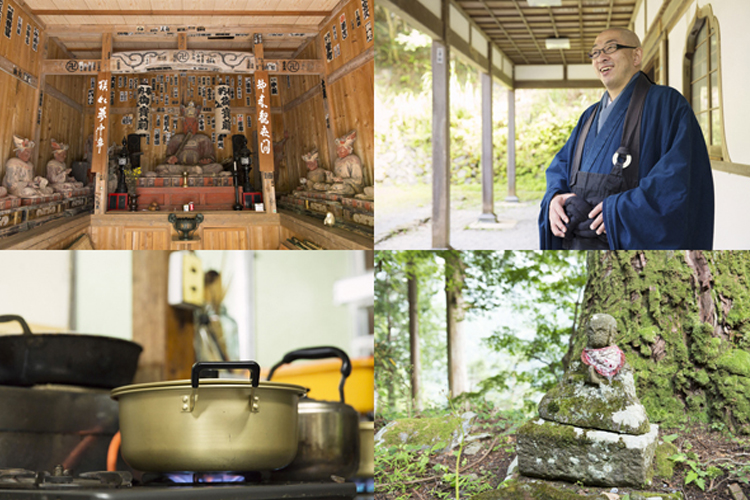Shojin Ryori (Buddhist Cuisine): Enjoy the traditional flavors at Taiyoji Temple
Sep 12,2013
Shojin Ryori (Buddhist Cuisine): Enjoy the traditional flavors at Taiyoji Temple
Sep 12,2013
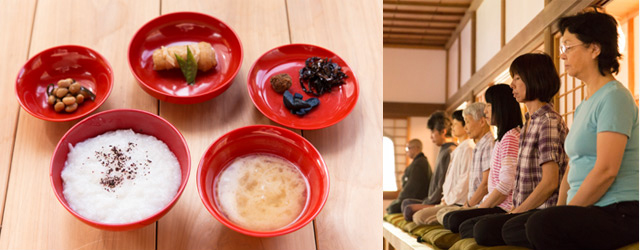
Discovering the Spirit of Shojin Ryori (Buddhist Cuisine) at a Zen Temple in the Sky
-Taiyoji Temple , Chichibu, Saitama-
Shojin ryori, or Buddhist cuisine, was originally a diet followed by ascetic monks. Because it excludes all animal protein, it is considered vegetarian.
This cuisine developed in Japan together with the spread of Zen Buddhism after the Kamakura period (1185 to 1333). Historians believe that seasonings and ingredients such as miso, tofu, konnyaku (konjac), and hijiki seaweed, cooking implements like earthenware mortars, and distinctive cooking methods to accentuate flavors were developed for shojin ryori well before becoming established parts of kaiseki cuisine and general Japanese cooking.
To learn about the true essence of shojin ryori for this article, we travelled to Taiyoji Temple, a Zen temple located deep in the mountains of Chichibu.
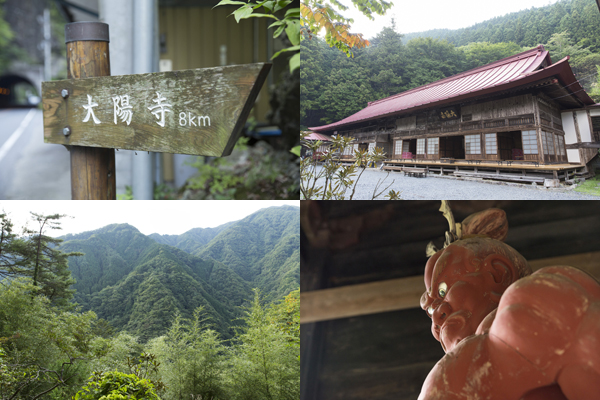
Situated in the mountains at an altitude of 850 meters, there are no houses within a five-kilometer radius of the site. Founded at the end of the Kamakura period, Taiyoji Temple (Rinzai sect) has existed quietly for some 700 years in this sequestered location far from the secular world.
“I would like visitors to reacquaint themselves with their true proportions, contrasted against this natural beauty that unfurls as far as the eye can see.”
These are the words of Asami Sotatsu, the 26th abbot (jushoku) of Taiyoji Temple, who came to the temple eight years ago after a life in Tokyo’s corporate world. Cellphone signals don’t reach here; all you can hear is the rush of a mountain stream and the calls of insects and birds. Sitting still in the tatami room of the main hall, constructed in the Edo period (1603 to 1868), is enough to feel your problems and predicaments being erased from your mind.
The streams speak with the Buddha’s broad tongue;
The mountains color in homage to his immaculate body.
(The flow of water through the valley is like blessed sutra;
The shape of the mountain is nothing less than a pure image of the Buddha.)
This is said to be the rejoinder of Bukkokukokushi, the founder of Taiyoji Temple, when asked by his disciples why he stayed deep in the mountains with no scriptures to learn from or Buddhist statues to worship. His words to this day still penetrate directly into our minds and souls.
It’s no wonder then that out of all the places in Japan, Taiyoji Temple was the clear No. 1 in a newspaper’s rankings of temple lodges for beginners. It exists in a world unchanged for 700 years with everything unnecessary stripped away. What extravagance.


The morning and evening sutra recitations are followed by a meal (in the mornings, the sutra recitation is followed by a seated Zen meditation (zazen)).
The time schedule at Taiyoji Temple is extremely simple. There are occasional Buddhist dialogs that take the form of question-and-answer sessions, but the rest of the time you are free to do what you like. Having said that, the Taiyoji Temple offers only a handful of options. You may walk around the area, transcribe sutras, sit in zazen meditation, or just curl up and take a nap.
“Relax and be your true self. I want you to notice the wonder of being able to live as you really are. Everyone has the heart of Buddha, a pure heart, within them. But the Buddha heart is like the center of an onion — it is wrapped in many layers. Transcribing sutras and zazen are practiced to remove these layers.”
This “homework” assigned by the abbot — noticing and getting in touch with your heart — is challenging. Relaxing is the easy part. But when I try to transcribe a sutra, my stomach growls and my concentration flounders, or when I attempt zazen, I keep catching myself about to doze off. It’s difficult to see any progress. This, perhaps, is what the saying “the impermanence of all things” is about. Nevertheless, it is true that you can be bored to the point of pleasure and that, in itself, is a valuable experience.
The Taiyoji Temple does have one unique recreation spot: An open-air onsen hot spring that the abbot took a year to build on his own. “I wanted at least one thing that I could enjoy for myself.” When the weather is fair, you can slip into the bath at night and gaze up at a sky full of stars. It may have been a consequence of our poor concentration during the day, but it clouded over on our night at the temple and we couldn’t observe any stars.
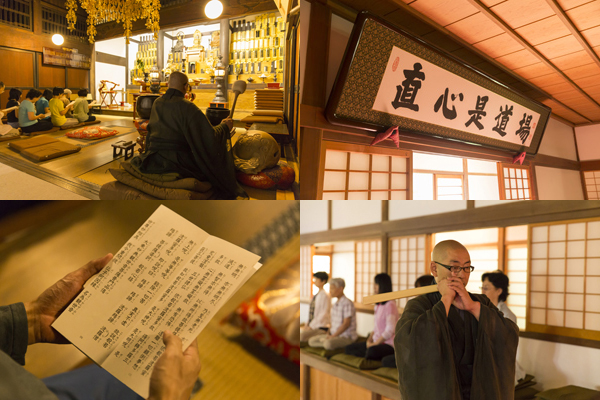

It is time for our long-awaited dinner. In Zen Buddhism, preparing meals is part of a monk’s training, and the monk at a Zen temple in charge of meals, called the tenzo, is held in high regard. At Taiyoji Temple, which is normally run by just one monk, the abbot serves as the tenzo as well.
“The menu is based largely on what I learned during my training at Myoshin-ji Temple in Kyoto. I use ingredients delivered by local farmers.”
Kenchin-jiru — a vegetable soup prepared using root vegetables and tofu — is said to have originated from Kencho-ji, a temple in Kamakura. The vegetables are parboiled the night before to extract broth. Dried shiitake mushrooms, made by drying fresh shiitake mushrooms in the sun, are reconstituted in water to extract more broth. The broth from boiled spinach served with sesame dressing is also used to complement the soup’s base. Made from leftover vegetables and crumbled tofu, kenchin-jiru is a prime example of ecological fare with almost no waste.
“I serve the simmered daikon radish with homemade chili miso. I bring out different flavors by choosing a variety of cooking methods — slow-boiling, sautéing, deep-frying — despite having only a few ingredients. According to the Sanmokudo (three halls of silence) tradition, no noise should be made during meals. But here you are free to enjoy your meal as you like. All I ask is that you remember to be grateful for nature’s bounty and to the farmers who grow the crops.”
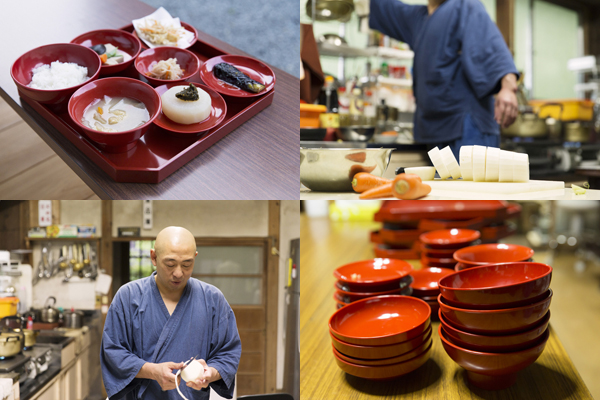
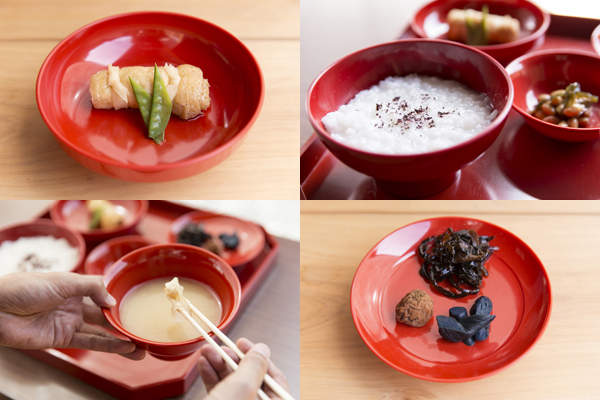
Shinoda-maki — burdock root, carrot, green beans, and other vegetables wrapped in a layer of deep-fried tofu. Homemade umeboshi pickled plums, kelp tsukudani (kelp simmered in soy sauce and mirin seasoning), and pickled eggplant. Soybeans stewed in a thick, sweet sauce. Miso soup with daikon radish and deep-fried tofu and served with rice porridge.
The morning menu is also light and simple, allowing you to appreciate fully the umami of each vegetable. The colors are beautiful, and the dash of salt, miso, and other seasonings add a subtle accent. All the ingredients and soup broth are vegetable-based. The water used for cooking is fresh spring water drawn from the headwaters of the Arakawa River.
Shojin ryori, which is gentle on the body and low in calories, is served only twice a day, morning and evening. Despite this, it leaves you with an ineffable feeling, as if your body has been purified.
“We cannot take eating lightly, as it is a part of life. When I am cooking, I always consider how to prepare food in a way that tastes good without wasting any of the precious ingredients that nature has given us. Every day, I am trained through cooking.”
There is a movement to have Japanese cuisine added to the UNESCO Intangible Cultural Heritage List, and shojin ryori, which is practiced humbly in close communion with nature, is certainly symbolic of Japan’s culinary tradition. Indeed, the many overseas guests who visit Taiyoji Temple relish shojin ryori, which uses every part of locally grown vegetables, from the outer layers to the core. Deep in the mountains, I experienced firsthand the underlying vitality of a Japanese morning meal.
